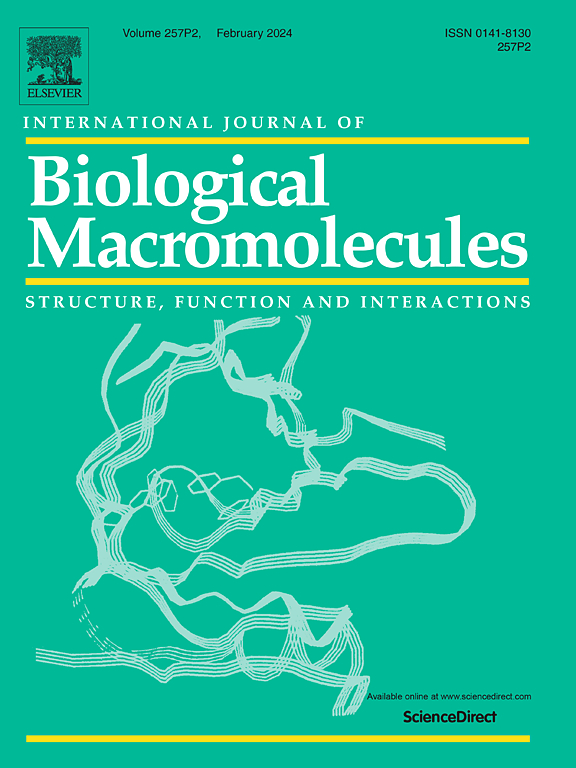SlbHLH92转录因子通过微调番茄中硫化氢的生物合成来增强抗盐胁迫的能力。
IF 7.7
1区 化学
Q1 BIOCHEMISTRY & MOLECULAR BIOLOGY
International Journal of Biological Macromolecules
Pub Date : 2024-11-06
DOI:10.1016/j.ijbiomac.2024.137294
引用次数: 0
摘要
持续的土壤盐碱化严重阻碍了植物的生长和全球农作物生产的可持续性。硫化氢(H2S)是一种重要的气态信号分子,在植物应对盐胁迫等各种环境因素的过程中发挥着至关重要的作用。然而,人们对转录网络如何调控番茄在应对盐胁迫时 H2S 的产生还不甚了解。在此,我们确定 bHLH 转录因子 SlbHLH92 在番茄(Solanum lycopersicum L.)中发挥转录激活剂的作用,上调参与 H2S 生物合成的 L-CYSTEINE DESULFHYDRASE 1(SlLCD1)基因的表达,从而增强植物对盐胁迫的耐受性。与野生型植株相比,当番茄暴露于盐胁迫时,过表达 SlbHLH92 会增强其耐盐性。相反,通过 RNAi 沉默抑制 SlbHLH92 的表达则会增加对盐胁迫的敏感性。随后的分子和生化研究证实,盐诱导的 SlbHLH92 会上调 SlLCD1 的表达,从而导致 H₂S 水平的增加,同时也会上调其他盐响应基因(SlCBL10 和 SlVQ16)的表达,方法是直接与它们启动子区域的特定顺式元件结合。此外,含有VQ-motif的蛋白质SlVQ16与SlbHLH92发生了物理相互作用,从而促进了其转录活性的提高。综上所述,我们的研究揭示了一种新的机制,即 SlbHLH92-SlVQ16-H2S 信号级联有助于提高番茄的耐盐性,为培育耐盐番茄品种提供了潜在的遗传目标。本文章由计算机程序翻译,如有差异,请以英文原文为准。
The SlbHLH92 transcription factor enhances salt stress resilience by fine-tuning hydrogen sulfide biosynthesis in tomato
Ongoing soil salinization severely hampers plant growth and the sustainability of global crops production. Hydrogen sulfide (H2S), acting as a critical gaseous signaling molecule, plays a vital role in plant response to various environmental cues such as salt stress. Nonetheless, it is not well understood how the transcriptional network regulates H2S production in response to salt stress in tomato. Herein, we determine that the bHLH transcription factor SlbHLH92 functions as a transcriptional activator in tomato (Solanum lycopersicum L.), upregulating the expression of the L-CYSTEINE DESULFHYDRASE 1 (SlLCD1) gene involved in H2S biosynthesis, thereby enhancing the plants' tolerance to salt stress. When exposed to salt stress, overexpression of SlbHLH92 in tomato leads to enhanced salt tolerance compared to wild-type plants. In contrast, suppression of SlbHLH92 expression with RNAi silencing results in increased sensitivity to salt stress. Subsequent molecular and biochemical investigations confirm that the salt-induced SlbHLH92 upregulates the expression of SlLCD1, leading to an increase in H₂S levels, as well as other salt-responsive genes (SlCBL10 and SlVQ16), by directly binding to specific cis-elements in their promoter regions. Furthermore, the VQ-motif containing protein SlVQ16 physically interacts with SlbHLH92, thereby promoting an increase in its transcriptional activity. Taken together, our study reveals an emerging mechanism in which the SlbHLH92-SlVQ16-H2S signaling cascade contributes to enhancing salt tolerance in tomato, presenting potential genetic targets for breeding salt-tolerant tomato cultivars.
求助全文
通过发布文献求助,成功后即可免费获取论文全文。
去求助
来源期刊
CiteScore
13.70
自引率
9.80%
发文量
2728
审稿时长
64 days
期刊介绍:
The International Journal of Biological Macromolecules is a well-established international journal dedicated to research on the chemical and biological aspects of natural macromolecules. Focusing on proteins, macromolecular carbohydrates, glycoproteins, proteoglycans, lignins, biological poly-acids, and nucleic acids, the journal presents the latest findings in molecular structure, properties, biological activities, interactions, modifications, and functional properties. Papers must offer new and novel insights, encompassing related model systems, structural conformational studies, theoretical developments, and analytical techniques. Each paper is required to primarily focus on at least one named biological macromolecule, reflected in the title, abstract, and text.

 求助内容:
求助内容: 应助结果提醒方式:
应助结果提醒方式:


